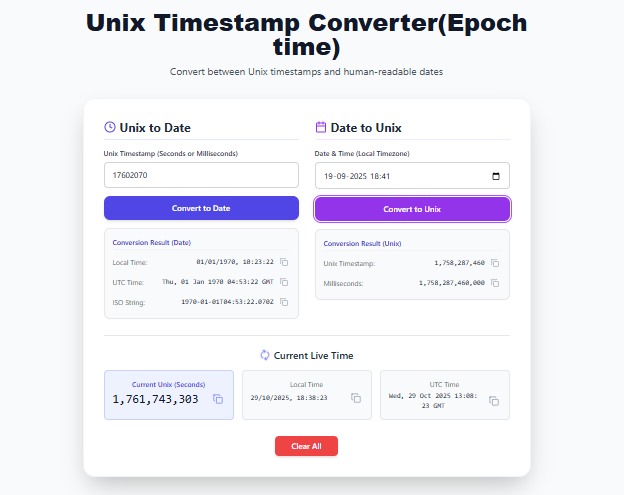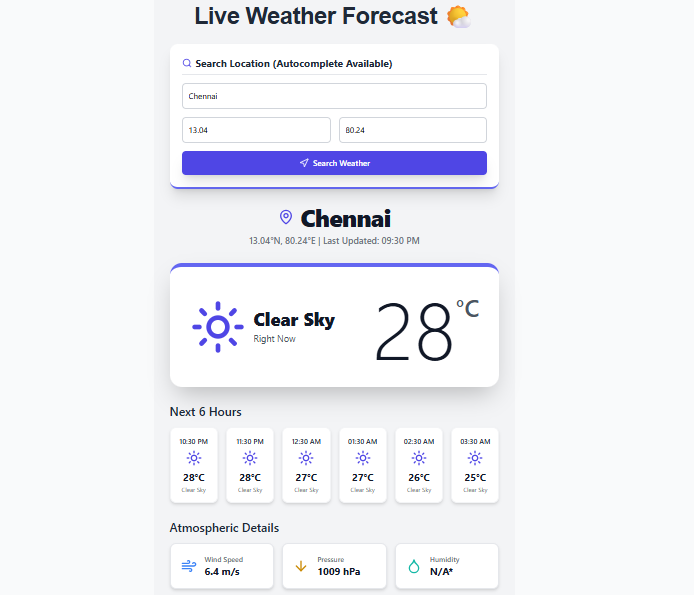🕒 Unix Timestamp Converter – Convert Unix Time to Human-Readable Dates Instantly
📘 Introduction
Timekeeping in computing systems follows a precise and universal standard called the Unix Timestamp. Whether you are a developer, data analyst, or system admin, timestamps play a crucial role in synchronizing and recording time events across platforms.
Solvezi’s Unix Timestamp Converter is an advanced yet simple tool that lets you convert timestamps to readable dates and convert dates back to timestamps -- all instantly, right in your browser. It supports seconds and milliseconds, and displays both local and UTC time formats, giving you a complete picture of your time data.
Use it here 👉 Unix Timestamp Converter
--
🧭 What is a Unix Timestamp?
A Unix Timestamp (also called Epoch time) represents the total number of seconds elapsed since January 1, 1970, 00:00:00 UTC -- known as the Unix Epoch.
This format is used universally in software systems, APIs, and databases because it avoids ambiguity caused by time zones and date formats.
For example:
0represents January 1, 1970, 00:00:00 UTC1730200000could represent October 29, 2024, 05:46:40 UTC (depending on your timezone)
A Unix timestamp can appear in two common forms:
- Seconds (10 digits): Example →
1730200000 - Milliseconds (13 digits): Example →
1730200000000
--
⚙️ Key Features of Solvezi’s Unix Timestamp Converter
- 🔄 Bidirectional Conversion: Convert Unix timestamps to date and date to Unix.
- ⏰ Real-Time Live Clock: Displays the current Unix time updating every second.
- 🌍 Timezone Awareness: Shows both UTC and local time formats.
- 🧮 Supports Seconds & Milliseconds: Automatically detects input type.
- 📋 Copy Functionality: Quickly copy any result with one click.
- ⚡ Instant Results: No backend -- 100% browser-based and fast.
- 📱 Mobile Responsive: Works perfectly on phones, tablets, and desktops.
- 🔒 Privacy Safe: All conversions happen locally -- no data is stored or sent.
--
🧩 How to Use the Unix Timestamp Converter
Using Solvezi’s tool is straightforward and efficient. Follow these quick steps:
1️⃣ Convert Unix Timestamp to Date
- Enter a Unix timestamp (in seconds or milliseconds).
- Click “Convert to Date.”
- Instantly see the results in:
- Local Time (based on your system)
- UTC Time (Universal Coordinated Time)
- ISO Format (e.g., 2025-10-29T14:35:00.000Z)
Example:
Input: 1730200000 → Output: October 29, 2024, 11:16:40 AM (local time)
2️⃣ Convert Date to Unix Timestamp
- Select a date and time using the input picker.
- Click “Convert to Unix.”
- The converter returns:
- Unix Timestamp (seconds)
- Milliseconds (13-digit precision)
Example:
Input: 2025-10-29T18:00 → Output: 1769690400 seconds or 1769690400000 milliseconds
3️⃣ View Live Current Unix Time
The page shows a real-time Unix counter, automatically updating every second. It also displays the current local time and UTC time -- useful for developers syncing with system logs or APIs.
4️⃣ Copy Any Value Easily
Each result includes a small copy button (📋). Click it to instantly copy the corresponding value -- like a timestamp or ISO string -- to your clipboard.
5️⃣ Clear All Inputs
Click the “Clear All” button to reset every field and start fresh.
--
🧮 Understanding Unix Time Formats
| Format Type | Description | Example |
|---|---|---|
| Unix (Seconds) | Total seconds since Unix Epoch | 1730200000 |
| Unix (Milliseconds) | Total milliseconds since Epoch | 1730200000000 |
| UTC Time | Coordinated Universal Time (no timezone offset) | Wed, 29 Oct 2025 12:00:00 GMT |
| Local Time | Based on system timezone | Wed, 29 Oct 2025 17:30:00 IST |
| ISO String | Machine-readable format used in APIs | 2025-10-29T12:00:00.000Z |
--
💡 Common Use Cases
| Use Case | Example |
|---|---|
| Software Development | Convert log timestamps to readable dates. |
| API Testing | Convert date to Unix format for REST requests. |
| Database Management | Convert timestamps stored in Unix format (e.g., MySQL, PostgreSQL). |
| Data Analysis | Compare time-series data in seconds or milliseconds. |
| Server Logs | Determine the exact event time in logs. |
| Blockchain | Decode block timestamps or transaction time data. |
| Scheduling Systems | Calculate reminders and expiration times. |
--
🧠 Why Unix Timestamps Are Used
Unix timestamps are universal because they are independent of time zones and daylight savings. They provide a single, numeric representation of time that can be compared, stored, and processed easily across systems.
Advantages:
- ✅ Compact numeric format (no ambiguity)
- ✅ Easy to compare and calculate durations
- ✅ Supported in almost every programming language
- ✅ Useful for sorting and event ordering
- ✅ Widely used in APIs, databases, and blockchain technology
--
🕓 The Unix Epoch – The Beginning of Time (for Computers)
The Unix Epoch marks January 1, 1970, 00:00:00 UTC -- a universal starting point for all Unix-based systems.
Every Unix timestamp counts seconds since this epoch. For example:
0→ Jan 1, 1970 UTC60→ Jan 1, 1970, 00:01:00 UTC86400→ Jan 2, 1970 UTC
Even today, most modern operating systems, programming languages, and databases rely on this concept.
--
🧮 Example Conversions
Example 1 – Timestamp to Date
Input: 1730200000
Output:
- Local Time: October 29, 2024, 10:46:40 AM
- UTC Time: October 29, 2024, 05:16:40 AM
- ISO String: 2024-10-29T05:16:40.000Z
Example 2 – Date to Unix Timestamp
Input: 2025-10-29T18:00
Output:
- Unix Timestamp: 1769690400
- Milliseconds: 1769690400000
--
🧰 Developer Tip – JavaScript Conversion Examples
If you’re a developer, you can convert between date and Unix timestamps directly using JavaScript:
Convert Date to Unix:
Math.floor(new Date('2025-10-29T18:00').getTime() / 1000);
Convert Unix to Date:
new Date(1730200000 * 1000);
Get Current Unix Time:
Math.floor(Date.now() / 1000);
--
🌐 Time Zones and UTC
A major benefit of Unix timestamps is that they’re time zone–agnostic. The timestamp always refers to a specific moment in UTC. Your browser or app converts it to your local timezone when displayed.
For example:
1730200000→ UTC: 05:16:40 AM → IST: 10:46:40 AM
This ensures consistency across devices and servers worldwide.
--
🔒 Privacy and Performance
Solvezi’s Unix Timestamp Converter is fully client-side, meaning:
- ✅ No data leaves your browser.
- ✅ No API requests.
- ✅ Instant conversions (no lag).
Your time data remains completely secure and private.
--
💬 Frequently Asked Questions (FAQs)
Q1. What is a Unix timestamp used for?
Unix timestamps are used to represent precise time moments in programming, databases, and systems. They simplify time storage and comparison.
Q2. What’s the difference between seconds and milliseconds timestamps?
Seconds timestamps have 10 digits (e.g., 1730200000). Milliseconds timestamps have 13 digits (e.g., 1730200000000). Milliseconds offer higher precision.
Q3. How do I convert Unix timestamps manually?
Use your programming language’s date functions or Solvezi’s Unix Timestamp Converter to get accurate results instantly.
Q4. Does the converter handle both past and future timestamps?
Yes. You can enter any timestamp, even one that’s far in the future or past, and it will return the correct date.
Q5. Why does my local time differ from UTC?
Local time adjusts for your timezone and daylight saving settings, while UTC remains universal.
Q6. Can I use this converter offline?
Yes. Once loaded, it runs completely offline in your browser.
Q7. Is this tool free?
Yes. Solvezi’s Unix Timestamp Converter is 100% free and always accessible.
--
🏁 Conclusion
The Solvezi Unix Timestamp Converter bridges the gap between human-readable dates and machine-friendly timestamps. It’s a must-have tool for developers, analysts, and anyone working with time-based data.
From debugging server logs to converting timestamps for APIs, this converter simplifies every step -- instantly, securely, and precisely.
👉 Try it now: Unix Timestamp Converter
--
Tags: unix timestamp converter, epoch time converter, date to unix timestamp, timestamp to date, utc to local time converter, solvezi tools







